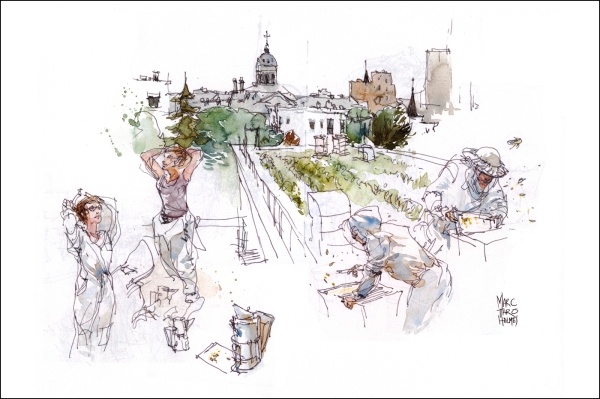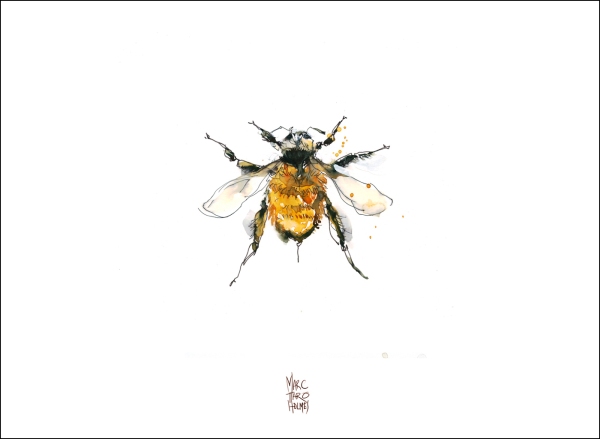Cracking open the Beehive : Visiting Montreal’s Rooftop Bee Colony to Talk about the End-of-the-World
I imagine we have all heard the stories about the vanishing honey bees, collapsing colonies, and the risk it all poses to the production of food. This spring it seems every news outlet was running something about bee-troubles. (Note – not a domestic honey bee in the sketch – I was down at the Jardin Botanique, so I popped into the Insectarium and sketched the exotic bees on display).
The strangest I saw was about bee rustling. This is crazy right? The idea that beehives are now so important to food producers, that it’s become worth it to steal some hard working beekeeper’s insects. Unscrupulous individuals show up in the dark of night, steal the bee-boxes, spray a new logo, and the bees are in a different field the next day. It’s a beehive chop shop!
That’s a spectacularly negative example of people adapting to the problem of bee scarcity.
When I heard there was a beekeeping collective here in Montreal, I thought – Let’s go down there and find out about some of the positive things we can do? See the sketches and interview below the fold:
It happens that the Apiculture Santropol Roulant Beekeeping Collective was just about to open their hives after the winter, to get a first look at how they are doing. They graciously invited me up to their rooftop garden to sketch the inspection, and to talk a bit about the potential bee-pocalypse.
I showed up on the appointed day, and followed along as they went through the ritual. Heading up to the rooftop garden, donning their bee-proof space-suits and one by one opening up the hives to survey the population of honeybees.
I wasn’t sure what to think – there was no suit for me! But nobody seemed too worried about it, so I just stayed calm and concentrated on my drawings. The bees basically ignored me. I was able to get right up to the action with no stings.
After all the action, I sent Noémie, (my contact at the Roulant), a few questions. In the spirit of the hive-mind she combined answers from all the beekeepers.
(MH) Can you tell us briefly about your urban beekeeping program here in Montreal? How long have you been at it, what are your goals?
We started the bee collective in 2011 in the spirit of reconnecting urbanites to the source of their food. We want to complete the full food cycle here at Santropol Roulant. Growing crops on the roof, pollinating with our bees, making meals on the ground floor, and composting in the basement.
Our vision is of a world where we work together to create conditions supporting a healthy honey bee population by actively contributing to biodiversity and training knowledgeable beekeepers.
We’re working to demystify the bee and talk about the importance of bees as pollinators. If you want more info on our mission, you can simply check our website [here].
(MH) I’ve been hearing so much scary stuff about bees dying off and the possible danger to human food production. (Not to mention the little guys themselves) What is your personal experience with the year-to-year health of your bees? Is it noticeable in Montreal?
First, we would say that Colony Collapse Disorder (CCD), the name given to the loss of beehives worldwide, is, so far, less present in Montreal than in the countryside where the use of chemical pesticides is more widespread.
Synthetic pesticides (called neonics) are technically illegal in Montreal, though they are a big concern in the rest of Canada and the world, and the main cause cited for CCD.
However we know that some people buy them elsewhere and still use them in the city. Overall it doesn’t seem to be as big of a concern downtown. The situation is different in the West Island, though. However we have heard McGill has recently banned neonics (systemic pesticides now known to affect bee populations) on their farmland (yay!).
Also, just to say, neonics are not the only thing responsible for CCD. Varroa destrutor, a very common parasite for the honey bee, climate change, and the use of bees as pollinators in conventional agriculture are among many other factors that might be causing CCD (by putting lots of stress on the hives).
We have seen some advantages in our own hives. For example, the ones at McGill are under harsher conditions than the ones at the Roulant. They are on a higher roof, with ventilation next to it, more cement in the surroundings. This can mean a more ‘defensive’ colony.
[It seems to be true – all the frames of bees looked healthy to me – swarming with little creatures. It looked like the keepers were getting good news from their inspection].
Noémie continues: Lastly, we would say that one concern, very local again, is not so much about CCD but about the ‘bee capacity’ in the city, i.e. how many beehives can we have in Montreal before saturating the city?
We have to keep in mind that bees collect nectar and pollen from certain plants and those are not necessarily in major quantities in Montréal (ornamentals are not their favorite). For this reason, before being worried about CCD, urban beekeepers have to be worried about keeping the right equilibrium between the amount of urban hives and the city capacity to feed them. This is why it’s important to continue to ‘green our city’, and to pay careful attention to which plant species we grow and plant (bee friendly plants are the best!)
On a similar note, we also have to be careful and make sure urban honeybees do not flood the city and ‘steal the spot’ of indigenous pollinators. And that’s another whole and very interesting issue.
This is one advantage of raising bees in the city in a collective model: 1-2 hives / 12 beekeepers is much better than 12 people with one hive each. We think the collective model is crucial for urban beekeeping. If everyone wanted their own beehive, the result would be disastrous!
(MH) How concerned are you for the future? Looking at it globally – is the Bee at risk of extinction?
While we don’t believe that bees will become extinct in the short or medium-term, it’s true beehives are under threat worldwide. Given their importance in the food cycle and in biodiversity, it is important for everyone to play a role to help keep them healthy and also to continue ‘using’ them as a tool to raise awareness around the importance of beekeeping and natural pollinators.
In other words, like many other issues in our environment, it’s hard to say exactly how resilient is nature against our acts of massive destruction. We would say that yes, the bee is at risk of extinction, like many, many other species at the moment, but there’s still a lot of hope if we put our priorities straight and do our best to save the species that feed us.
(MH) If it really gets as bad as they say in the news, is there a backup plan for human reliance on Bees as pollinators? What would we do without them?
The backup plans are scary to us, sincerely, and they look like using slave labor to hand pollinate our crops (there are articles about this flying around). They do already pollinate by hand in some parts of the world where biodiversity was reduced.
We think, still, that it is important to remember that honeybees are just one type of pollinator that have been selected and raised by humans for their honey. Many other indigenous pollinators exist, and they also need to be taken care of. Some of them are also very specific to certain plants and losing them would also mean losing the plants they pollinate.
(MH) What should average citizens be doing if they’re concerned about the health of bee colonies and the security of food production?
- Buy organic honey,
- Plant bee-friendly flowers,
- Build a bee hotel (for indigenous bees). (Here’s some info how to take action).
- Support organic and urban agriculture which promotes biodiversity and healthy habitats for pollinators,
- Reduce your consumption of monoculture crops. Mainly, those which rely heavily on commercial (stressful) honeybee pollination (cultivated cranberries and blueberries in Quebec, Californian almonds, etc.),
- Ask your local government for neonics to be banned until pesticides can be rigorously shown to be safe for bees,
- Join beekeeping collectives/groups. Learn to raise bees in a sustainable way!
(MH) Thanks very much to Noémie and the other beekeepers for their answers!
I have to say, this has been eye opening for me. You hear about these scary things in the news over and over, but it’s hard to know if the media has got it right. The networks put up their dueling experts to give you ‘both sides of the story’, and you come out not really sure what to think.
Having the chance to ask someone face to face, and to see what they are doing about an issue – it’s really the only way to make up your own mind. Perhaps you’ll run across a beekeeping collective in your own city. It might be worth a visit to learn more.
~marc







Great read and wonderful sketches
Reblogged this on Innate Ecology and commented:
Ever wondered about whats happening with the wondrous bee, pollinator of food sources? Here is a spectacular story on bees, bee co-operatives, bee sketches and bee love. Marc Taro Holmes works wonders with words and pens.
Thank you so much for such interesting article! I am spending some time back in my family’s place in Argentina, eating local, raw honey, and I will share your article with my brother who started to keep beehives in his country house.
And your sketches are always so beautiful!
Thanks Carol! I hope his bees are in great health!
Fantastic sketches! Congrats!
Thanks for this article-I’m sharing it with my brother! He’s renovating his house and found that there were three bee colonies living in separate parts of the yard. They’d be destroyed by the renovation, so he’s trying to move them and start keeping them as beehives, he’ll find this article most helpful!
I really enjoy seeing your sketches-they’re always so beautiful and they brighten up my day!
Hey Marc…odd, I thought I left a comment here earlier. I’ll summarize by saying I love drawing bees, and my academic background is sustainable agriculture, so this post hits all the sweet spots!
I came back to share this link, which might be fun/useful for anyone else thinking of sketching bees: http://www.fs.fed.us/wildflowers/pollinators/documents/BumbleBeeGuideEast2011.pdf.
Hey thanks – good stuff. I’m wanting to do some in-studio bee paintings (someday – time allowing:) – will come in handy. Keep in touch if you hear of any shows/events with themes like this – be a good reason for me to make the work happen :)
OK, will do. Same here. You probably hear about more shows (advertised in English, anyway) than I do. :)
Where can people buy Neonicotinoids-free plants???